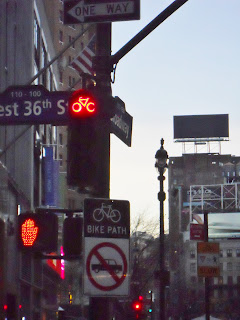So I have been having a bit of a problem violating social norms. Mostly, I haven't been getting the responses I anticipated. At first I was wondering if maybe it was because I looked too naive but after reading Stephanie's blog, I am wondering if maybe its just NY. Here are some of my experiences:
Please use revolving doors
I walked through the double doors at work, the ones with the signs posted asking us to use the revolving doors and nothing happened. I walked right through, with an air of confidence and an 'I know exactly what I am doing' expression and I got nothing. The guard didn't look at me. People went about their business and no one followed me. I wasn't too worried about the reaction I intended to receive but was very upset when I got no reaction.
Bagging Produce
Went to the grocery store and decided to ban the produce plastic bags. We regularly bring our own bags to the grocery store but always bag up our produce by category just as everyone else does. I thought about it and realized it was just a convenience and sort of a waste. I don't really think this falls under the category of social norm but this simple change got a reaction so I thought I'd share. I picked up apples and threw them right into my bag loose. I did the same with grapefruit. None of my fellow shoppers seemed bothered by my decision but when time came for check out the register lady seemed quite annoyed. She gathered all of my produce up, categorized it to weigh, and put it in a plastic bag. When I told her I didn't need the bag she said "well, they are all already in there" so I just took the bag. I guess my attempt to be less wasteful kind of failed but at least I got a reaction.
Dog park
I pass by the dog park everyday on my walk to work. I am very allergic to all animals with fur but I do love them. I have to continually disappoint my boyfriend, Erik, every time he asks if we can get a dog. Yes, he does know the answer and ask continually anyway. So on our way home from OHNY tours, I asked him if he would like to go to the dog park. He, of course, excitedly said yes. We entered the gated area with obviously no dog of our own. I looked around for reactions from dog owners as Erik talked to all the dogs. There were only a few owners that afternoon but not a one of them seemed bothered by our visit. We hung out for a while playing with other people's dogs and then left again obviously petless. Unfortunately, not much came out of our violation other then a saddened Erik still longing for a 'pup pup.'
I am hoping to push the boundaries this coming week to see if I can get better reactions than I have been receiving. I am thinking of doing a bit of experimenting to see if norm violations I made here in NY are more or less accepted in Harrisburg PA on a trip out there next weekend. I am also thinking about having Erik commit some of the same violations I commit to see if he receives different reactions, being a male.
These norm violations reminded me of a very specific memory from my semester abroad. I arrived in Italy in January, a time very few tourist, other than American students, can be found in Florence. I enjoyed a few month there before tourist season official began. I remember a bright day right around Easter when I left for class to find the street crowded with outsiders bunched in groups pointing at the Duomo. As I dodged the masses I remember being annoyed. Later that same day, my friend and I were enjoying dinner at our favorite local pizza place, Nerone, when an I noticed a obviously American group in the front of the restaurant. I remember a woman from the group, in a loud bothered tone asking the hostess how they didn't know when there would be a table available. She wanted to know why they couldn't just make reservations. "If we are going to wait then tell us where we can get a drink. Can I at least get a beer." I was mortified. I remember thinking, "this is why no one likes Americans. I can't believe I am associated with people like this. Italy is not Disney World and who in their right mind orders beer in Italy."
Violations of social norms are going to be different for every society and culture. Social norms may be most obvious in areas where 'norm' is well defined for the everyone. I doubt that American woman in Florence even knew how obnoxiously she was violating a Italian norm, even though at home her actions may have been acceptable. I wonder if at home in America, she tells people she is Italian.



















